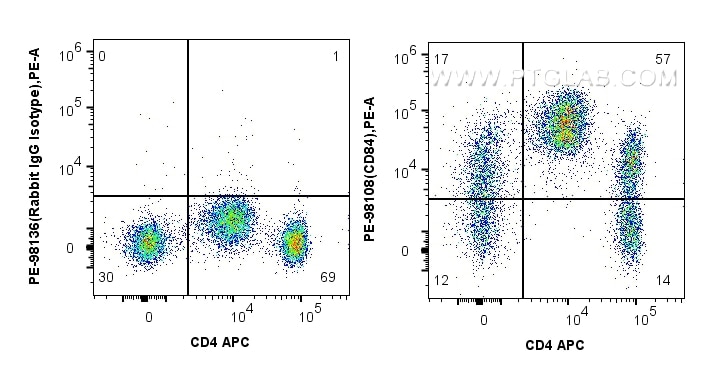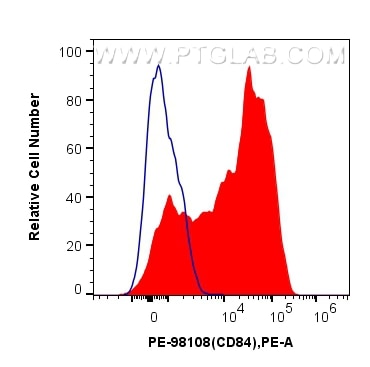Validation Data Gallery
Tested Applications
| Positive FC detected in | human PBMCs |
Recommended dilution
| Application | Dilution |
|---|---|
| This reagent has been pre-titrated and tested for flow cytometric analysis. The suggested use of this reagent is 5 ul per 10^6 cells in a 100 µl suspension or 5 ul per 100 µl of whole blood. | |
| Sample-dependent, Check data in validation data gallery. | |
Product Information
PE-98108 targets CD84 in FC applications and shows reactivity with human samples.
| Tested Reactivity | human |
| Host / Isotype | Rabbit / IgG |
| Class | Recombinant |
| Type | Antibody |
| Immunogen | Recombinant Protein 相同性解析による交差性が予測される生物種 |
| Full Name | CD84 molecule |
| Calculated molecular weight | 345 aa, 39 kDa |
| GenBank accession number | BC020063 |
| Gene Symbol | CD84 |
| Gene ID (NCBI) | 8832 |
| RRID | AB_3674023 |
| Conjugate | PE Fluorescent Dye |
| Excitation/Emission maxima wavelengths | 496 nm, 565 nm / 578 nm |
| Form | Liquid |
| Purification Method | Protein A purification |
| UNIPROT ID | Q9UIB8 |
| Storage Buffer | PBS with 0.09% sodium azide and 0.5% BSA. |
| Storage Conditions | Store at 2-8°C. Avoid exposure to light. Stable for one year after shipment. |
Background Information
CD84, also known as SLAMF5, is a member of the CD2 subfamily of the immunoglobulin receptor superfamily (PMID: 9310491). CD84 is a single-chain type-I glycoprotein composed of two extracellular Ig-like domains, a hydrophobic transmembrane region, and a cytoplasmic domain. It is broadly expressed on almost all leukocyte subsets. CD84 functions as a homophilic adhesion molecule, whose signaling can activate or inhibit leukocyte function depending on the cell type and its stage of activation or differentiation (PMID: 30522694).
Protocols
| Product Specific Protocols | |
|---|---|
| FC protocol for PE CD84 antibody PE-98108 | Download protocol |
| Standard Protocols | |
|---|---|
| Click here to view our Standard Protocols |

